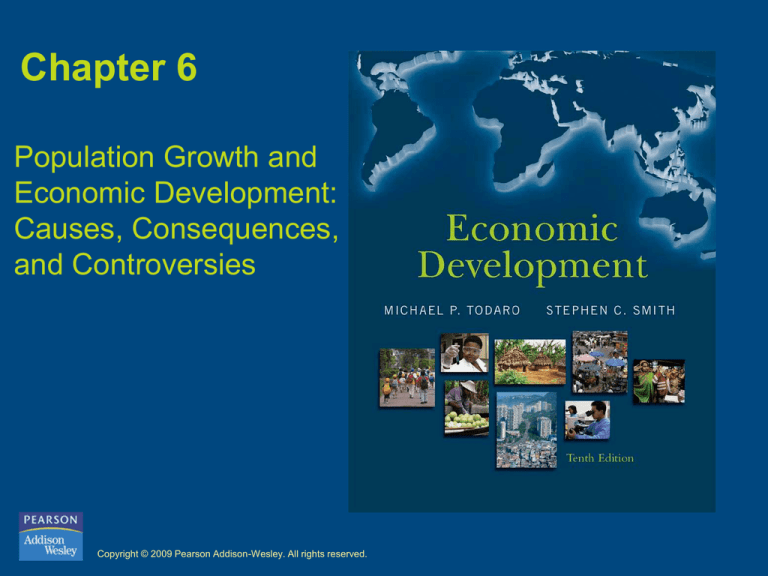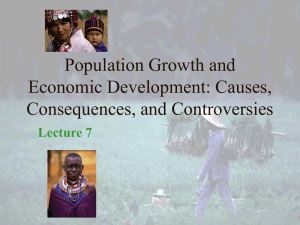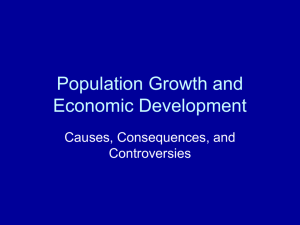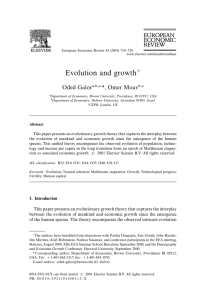
Chapter 6
Population Growth and
Economic Development:
Causes, Consequences,
and Controversies
Copyright © 2009 Pearson Addison-Wesley. All rights reserved.
Population growth and Standard of living
Six major issues:
– Impact of population growth and standard of living.
– Population growth on employment (GDP per capita).
– Population growth rates affect poverty.
– Population growth and Health care.
– Population growth and education.
– Relationship between poverty and family size.
6-2
Population growth and economic
development, consequences, controversies
•
Historical and recent population trends.
•
Structure of world population by regions.
•
Fertility and mortality rates.
•
Demographic transition.
•
Malthusian population trap.
6-3
Estimated World population growth
6-4
Historical Population Trends
Growth rate of World population has increased after 1950:
•
Falling mortality rates (resulting from rapid technological
advances in modern medicine and spread of modern
sanitation methods) raised population growth rates.
•
Malnutrition – Health conditions decline in mortality rates.
Via access to modern medicine.
Proliferation of public health facilities.
Clean water supplies.
Improved nutrition.
Public education.
6-5
World population growth (1750-2050)
6-6
Structure of the world’s population
By geographic region:
Africa: >100 percent increase through the year 2050.
Latin America: >50 percent.
Asia: >50 percent.
Europe: >5 percent
North America: 50 percent
6-7
Figure 6.2: World population distribution
by region (2003 and 2050)
6-8
Structure of the world’s population
By birth and death rates:
•
Population increase = (measuring the excess of births over deaths)
+ (measuring immigrants in excess of emigrants).
•
Data show net international migration is limited in magnitude.
•
Faster population growth in developing world.
Birth rates (Less developed) >>> Birth rates (Developed).
Death rates (Less developed) > Death rates (Developed).
6-9
Fertility rate for selected countries
6-10
Population pyramids: Age structures 2005
6-11
The Demographic Transition
Process through which fertility rates eventually fall to replacement
levels.
Stage I:
High birth rates and high death rates (slow growing population).
Stage II:
Continued high birth rates but declining death rates (beginning of
demographic transition.
Stage III:
Falling birth rates (population growth is stabilized).
6-12
Figure 6.6: The traditional demographic
transition.
6-13
Figure 6.7: The demographic transition
in developing countries
6-14
High fertility in developing countries
Malthusian Population Trap postulates that:
• Food supplies expand only at arithmetic rates due to diminishing
returns to the fixed factor land. Population increase geometrically.
• Growth in food supplies can’t keep pace with expanding population
6-15
High fertility in developing countries
Critical Assumption (Malthusian Population Trap):
– The higher the level of per capita income the faster the growth in
aggregate income.
Rationale:
– Countries with higher per capita incomes generate higher savings
therefore more investment that leads to faster capital accumulation
and growth.
Result:
– In the absence of preventive checks (birth control), positive checks
(starvation, disease) provides the restraining force on population growth
6-16
The causes of high fertility in developing
countries.
Main Criticism of the Malthusian model:
Ignores the impact of technological progress.
Rapid technological improvement increasing returns to scale
rather than decreasing returns to scale (help raise significantly
the productivity of the fixed factor land.
6-17
How technological and social progress
allows nations to avoid the population trap
6-18
The causes of high fertility in developing
countries: The Malthusian and
household models
• The microeconomic household theory of fertility.
• The demand for children in developing countries.
– First two or three as “consumer goods”.
– Additional children as “investment goods”.
6-19
The causes of high fertility in developing
countries: The Malthusian and household
models.
Demand for Children Equation
Cd = f (Y , Pc, Px, tx), x = 1,..., n
Where:
Cd is the demand for surviving children
Y is the level of household income
Pc is the “net” price of children
Px is price of all other goods
tx is the tastes for goods relative to children
6-20
The causes of high fertility in developing
countries: The Malthusian and household
models
Demand for Children Equation
Cd = f (Y , Pc, Px, tx), x = 1,..., n
Under neoclassical conditions, we would expect:
¶Cd
>0
¶Y
¶Cd
<0
¶Pc
¶Cd
>0
¶Px
¶Cd
<0
¶tx
6-21
The causes of high fertility in developing
countries: The Malthusian and household
models
Some empirical evidence:
Implications for development and fertility
–
–
–
–
–
–
Women’s Education, role , and status.
Female nonagricultural wage employment.
Rise in family income levels.
Reduction in infant mortality.
Development of old-age and social security.
Expanded schooling opportunities.
6-22
The consequences of high fertility:
Classical Conclusion:
•
Rapid population growth (RPG) lead to serious development
problems.
Two opposing views on the impact of RPG:
1.
Not a real problem.
2.
Real problem.
6-23
It’s not a real problem
The real problem is not RPG but the following issues:
Underdevelopment:
•
Development should be the goal because it will generate
economic progress and other social mechanisms that will
automatically regulate population growth.
6-24
It’s not a real problem
The real problem is not RPG but the following issues:
Population Distribution:
•
•
Main problem is the spatial distribution of population.
Governments should reduce rural-urban migration to bring about
a more efficient population distribution in terms of available
productive resources.
Subordination of Women:
•
•
Population growth is a natural outcome of women’s lack of
economic opportunity.
Education and empowerment of women (Bank of the poor).
6-25
It’s not a real problem
•
•
It’s a deliberately contrived false issue:
Population growth is an issue intentionally created by dominant rich
country agencies and institutions to keep less developed in their
under developed status.
It’s a desirable phenomenon:
Population growth is an essential ingredient to stimulate economic
growth:
Consumer demand to reach the economies of scale in production
to lower unit production costs.
6-26
It’s a real problem
• Unrestrained population growth is the principal cause of poverty,
low levels of living, malnutrition, poor health conditions,
environmental degradation, etc.
• Population stabilization is the most immediate task even if it
requires severe and coercive measures imposed on LDCs.
6-27
It’s a real problem
Theoretical argument (Population-poverty cycle theory):
• Population growth delays the economic growth process by:
Reduced private savings at the household level.
Reduced public savings due to increased government spending on
basic services to the additional people.
• Lower aggregate savings will slow down the capital accumulation
resulting in low levels of investment and slower economic growth.
6-28
It’s a real problem
Empirical argument:
Recent research document the negative consequences of RPG on:
•
Economic growth (RPG lowers per capita income growth in LDCs).
•
Poverty and inequality (consequences fall heavily on the poor).
•
Food (given RPG trends, feeding everybody gets more difficult).
•
Environment (RPG leads to faster environmental degradation).
6-29
Goals and objectives:
toward a consensus
Three policy goals to deal with problems associated with RPG:
•
Policies should target not only the population variable but also the
underlying social and economic conditions of underdevelopment.
–
•
absolute poverty, widespread unemployment, malnutrition, etc.
Family planning programs should provide education and
technological means to regulate fertility.
6-30
Some Policy Approaches
What developing countries can do:
– Persuasion through education.
– Financial assistance for family planning programs.
– Manipulate incentives and disincentives for having children.
– Raise the socioeconomic status of women.
6-31
Table 6.4: Countries adopting familyplanning programs (1960-1990)
6-32








